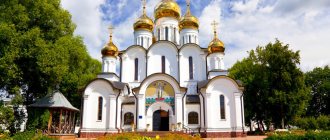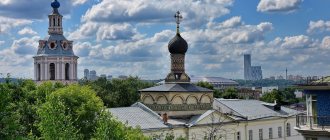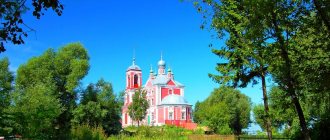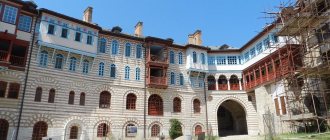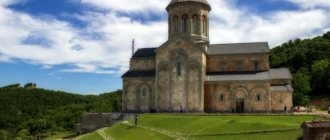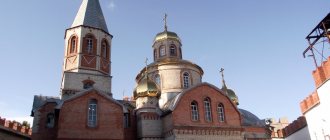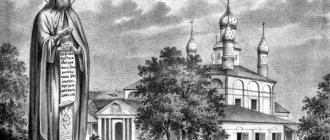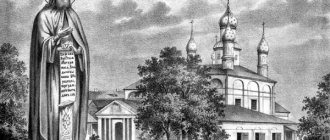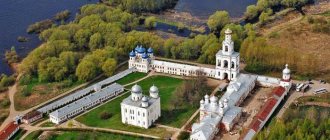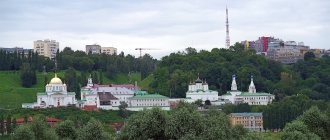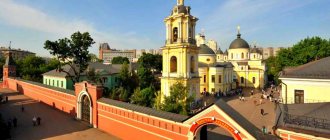Feodorovsky Monastery of Pereslavl-Zalessky (Russia) - description, history, location. Exact address and website. Tourist reviews, photos and videos.
- May tours
to Russia - Last minute tours
to Russia
The Feodorovsky Monastery of Pereslavl-Zalessky is an ancient, bright and calm monastery, the air of which is always transparent and quiet, despite its proximity to the Moscow highway. Founded back in the 13th century, the monastery endured many hardships and hardships, gained the favor of the sovereigns, then was forgotten and destroyed - and today it is again ready to welcome pilgrims and everyone who wants to get acquainted with its architecture and simply escape the hustle and bustle of everyday life.
The Feodorovskaya Church was founded by order of Ivan the Terrible in honor of the birth of his son Fedor.
The history of the creation of the Feodorovsky Monastery
According to legend, in 1304, on June 8, when the Orthodox Church celebrates the memory of the Great Martyr Theodore Stratilates, a large battle took place south of the city of Pereslavl. The regiments of Prince of Moscow Yuri Danilovich, grandson of Alexander Nevsky, and Prince Mikhail Yaroslavich Tverskoy took part in the confrontation.
The reason for the civil strife was Tver's desire to capture Pereslavl. In the bloody battle, there were many dead on both sides, including the boyar Akinf, who led the soldiers from Tver. The victorious Moscow prince ordered the founding of a male monastic monastery on the site of the battle.
The very first documentary evidence of the monastery dates back to 1511
. At that time he flourished, and the Grand Duke himself patronized him. And the monastery sacristy was constantly replenished with rich offerings from boyars and other noble nobles.
Cathedral of Theodore Stratelates
The formation of the Feodorovsky Monastery as a nunnery
Until 1667, the Feodorovsky Monastery was a men's monastery. But that year a terrible plague epidemic occurred throughout Muscovy. The monastery, like the whole city, was severely depopulated. And in Pereslavl there were a lot of women and girls left whose entire relatives had died. Then, by the decision of the head of the church, Patriarch Joseph, and by decree of Emperor Alexei Mikhailovich, a women’s monastery was created for them.
The 10 male monks who remained in the monastery by that time were distributed to other monasteries - Goritskaya, Nikitskaya and Danilovskaya, and new nuns were housed in the premises. At the same time, the monastery received land plots for management so that the nuns had the opportunity to feed themselves.
By the end of the 17th century, the Feodorovsky Monastery became a place where women were forcibly sent to be tonsured for various offenses - drunkenness, theft, church schism and for political reasons. So Catherine I forcibly sent Anna Feodorovna, the wife of the Senate Prosecutor General Pavel Ivanovich Yaguzhinsky, to the Feodorovsky Monastery, who received the name Agafya when she was tonsured. She died in the monastery, having lived as a monk for 10 years.
Church of the Presentation of the Blessed Virgin Mary into the Temple
The royal family never left the Feodorovsky Monastery with their attention. He was favored by Boris Godunov, Tsarina Natalya Kirillovna, mother of Peter I, and his sister Tsarevna Natalya Alekseevna
. The latter, with her own money, organized the construction of the Vvedenskaya (1710) and Kazan (1714) churches in the monastery. Praskovya Fedorovna, the wife of Ivan, the elder brother of Peter I, also made donations to the monastery treasury.
In 1722, Tsar Peter I himself came to the Feodorovsky Monastery and brought with him European looms, materials for work and skilled weavers. He ordered the nuns to learn spinning following the example of German spinners.
Over time, the monastery became famous for its workshops. It produced fabric for the needs of the royal court, and also made church vestments and utensils. Gold seamstresses, embroiderers and weavers worked here. They even had their own pottery and icon painting workshops. The monastery experienced its greatest prosperity at the time when the trade route leading from Moscow to the Volga banks began to pass through Pereslavl.
By the beginning of the last century, this convent was the most numerous in the city; up to five thousand nuns lived here. In 1913, Emperor Nicholas II visited the convent, and in memory of his visit, a linden alley was planted, which has survived to this day.
.
From left to right: the belfry above the Holy Gate, the chapel-well of the Great Martyr. Fedora Stratilates
During the years of Soviet power, the Feodorovsky Monastery shared the fate of most Orthodox churches. At first it was transformed into an agricultural artel, and in the mid-20s it was closed altogether. The last priest, Nikolai Viktorovich Dunaev, was shot in 1937. And the last abbess of the Feodorovsky monastery - Olympias (in the world - St. George) was arrested. Later, having served her sentence, she lived out her days in a guardhouse on the monastery grounds.
At various times, the monastery premises housed a colony for children, a nursing home, a military unit, an office of a construction trust and one of the institutes of the Russian Academy of Sciences. The cathedral was given over to a clothing warehouse. Unfortunately, over the years, most of the unique paintings inside the church premises were destroyed. At the end of the 1960s, restoration of the buildings began. And church services in the monastery were resumed only in 1998.
Under the rule of the God-fighters
This continued until 1917, until the new government, for the sake of “universal happiness,” considered it necessary to abolish the monastery, close the schools, disperse the nuns, and send their overly energetic abbess to camps for many years. Returning back as a decrepit old woman, she spent the last years of her life in a cramped monastery gatehouse.
After the Fedorov Convent (Pereslavl-Zalessky) was closed, its nuns created a small community, trying to adapt to new circumstances in this way, but in 1923 it was liquidated. The monastery buildings, surrounded by a strong wall, were used by the new government both as warehouses and as production premises. At one time there was even a colony for juvenile delinquents there. In the post-war years, the territory was given to one of the military units, and later a research institute was located there.
Architectural monuments on the territory of the Feodorovsky Monastery
Feodorovsky Cathedral is the most important temple of the monastery. It occupies the central part of its territory. This cathedral has an interesting history. In 1557, Tsar Ivan the Terrible was present at the consecration of one of the churches in Pereslavl. He was accompanied by his wife, Tsarina Anastasia, who was in her last week of pregnancy.
Church of the Kazan Icon of the Mother of God
As soon as they passed the city outskirts, the queen had a son. This happened 7 km from the city in the village of Sobilovo. And at the site of the appearance of the heir, named Fedor, a chapel-cross was built.
The grateful Ivan the Terrible ordered the dilapidated wooden church in the monastery to be replaced with a five-domed stone cathedral. Today it is the oldest surviving monastery building. The temple is traditional - it has four powerful pillars and five onion-shaped domes. Later the cathedral underwent several reconstructions. Inside this temple, paintings by the Italian master Nicolo Tonci have been preserved.
And in 1681, they decided to replace the wooden chopped walls of the monastery with a stone wall, which has partially survived to this day. It was not intended for defense, so there are no towers or loopholes on this fence.
The main entrance to the monastery has always been the Holy Gate. When restoration was carried out in the 2000s, a small bell tower was built over them.
To the right of the entrance gate is the chapel-well of Fyodor Stratelates (XVII century). And from the north there is a three-story hotel, which was built later - at the end of the 19th century.
Next to the Feodorovsky Cathedral is the Vvedenskaya refectory church. It has only one floor and is small in appearance. But inside this church is quite spacious due to the large chapels. All three apses of the temple are decorated with elegant semi-columns. Its side chapels are decorated in the same way.
Cathedral of Theodore Stratelates
The compact territory also accommodated a one-domed church, consecrated in honor of the Kazan Icon of the Mother of God (1714). It was erected at the monastery’s two-story hospital. Nearby are brick cells (XVII-XIX centuries), the abbot's building (XVII century), a new refectory building, a strange reception and regency house (XIX century).
Monastery in the space of mercy
Feodorovsky, in honor of the Great Martyr Theodore Stratelates, the convent in Pereslavl-Zalessky stands on land that has a rich history, glorified by the appearance of great saints and the deeds of outstanding rulers of the Russian state. The monastery itself, which has existed - if you go by the first mention in the chronicles - for more than seven centuries, is a witness and participant in many events, both glorious and tragic. A witness, by the grace of God, alive and active. The monastery courageously overcame the main difficulties of restoration after decades of Soviet institutions running it - the main burden of this work fell on the shoulders of Abbess Varvara (Chekotkova; † 2017). Today, under the direction of Mother Varvara’s successor, Abbess Daniila (Severinenko), the monastery lives in an orderly rhythm of divine services and monastic works. At the same time, the ancient monastery enjoys considerable attention from both pilgrims and tourists, who visit Pereslavl-Zalessky in large numbers. This encourages the sisters to carefully study its past - fortunately, the archives are well preserved and are waiting for their researchers.
And recently, the monastery has become a participant in new interesting endeavors, being in many ways their initiator. We are talking about projects that, at first glance, have different tasks, but in fact are closely connected by common goals: this is the permanent St. Feodorovsky historical and cultural forum, and perpetuating the memory of the Pereslavl period of the life of St. Luke (Voino-Yasenetsky), and the opening in the city of the Orthodox palliative hospital...
We talked about all this with Abbess Daniela. Mother’s assistant, coordinator of the St. Theodore Forum, novice Natalia Yamoldinova, took part in the conversation.
Mother Daniel, how did these projects arise, where did it all begin?
On February 21, 2022, the 1700th anniversary of the martyrdom of the Holy Great Martyr Theodore Stratilates, our heavenly patron, was celebrated. And we decided to devote several events to this date: we wanted to hold a conference, jointly comprehend the phenomenon of martyrdom as a testimony to Christ, and why this may be relevant today. I also wanted to convey to people new historical data about the monastery, since Pereslavl guides often rely in their stories on established myths and local legends, but do not have reliable information... And so in March 2019, a round table was held “The role of monasteries in the formation of the socio-cultural space of small cities." Initially, this event was not yet called a forum, its idea arose directly in the process of our communication, and Bishop Feoktist of Pereslavl and Uglich proposed holding the Forum annually.
At the same round table, we first raised the issue of the complex of buildings of the Pereslavl Zemstvo District Hospital, where in 1910–1917 the chief physician was Valentin Feliksovich Voino-Yasenetsky, the future Saint of Crimea Luke. Not long before, there was a rumor that the hospital buildings, which were gradually falling into disrepair, might be demolished in order to build some commercial establishments on this site. We, of course, were concerned and decided to draw public attention to this problem. The initial task was to try to put the territory in order as far as possible and ask the government of the Yaroslavl region to transfer the hospital complex to the use of the Church.
Saint Luke had a lot to do with the Feodorovsky Monastery, didn’t he?
Yes, Saint Luke is especially close to our monastery. He not only knew Mother Abbess Eugenia, but also provided medical assistance to the monastery free of charge, of which both written and oral evidence has been preserved. Correspondence between Abbess Evgenia and the medical department of the Vladimir provincial government was found in the archives; in particular, there is a letter from mother confirming that the doctor Valentin Feliksovich Yasenetsky-Voino undertook to provide medical assistance to the sisters and families of clergy, “giving his labors free of charge.” Valentin Feliksovich's wife had a warm relationship with the abbess. The Voino-Yasenetskys’ former maid, Elizaveta Kokina, recalled that about once a month their mother came to them to “drink tea.” There is also a photograph where Mother Evgenia is captured with Anna Vasilievna and the children - perhaps the picture was taken by Valentin Feliksovich himself. That is why the memory of St. Luke is so dear to us.
Bishop Theoktist, who headed the round table, supported our initiative, and then proposed to register the territory of the hospital for the use of the Feodorovsky Monastery. Since there are several buildings there, we immediately thought that we needed to make this place not only a memorial or museum, but also to continue the work of St. Luke - the work of mercy, of helping people.
Do local authorities support you and provide assistance?
The city administration was friendly. But the territory was owned by the region, and when we turned to the department of property and land relations, they also supported us and helped us find an acceptable transfer option. So far we have received this place for use for 49 years. That is, we have every reason to develop some kind of activity, attract partners and benefactors.
Object of social assistance and social entrepreneurship
What guided you when choosing the directions of this activity?
These directions appeared naturally, based on the needs of the city. In small towns, assistance to people with disabilities and people with disabilities is especially in demand. Palliative care. Consultative and diagnostic. Rehabilitation after strokes, injuries, road accidents... Of course, Pereslavl-Zalessky is no exception.
For example, with regard to children and adults with disabilities: most often, work with them relies on the enthusiasm of volunteers. In our city there is a volunteer group for play rehabilitation of people with multiple developmental disabilities under the leadership of S.A. Starostina. Svetlana Aleksandrovna is a member of the Public Council for Children’s Rights in the Yaroslavl Region, deputy chairman of the Yaroslavl branch of the National Parents Association, a very active person, in fact, she supports all this volunteer activity with the energy of her personality. And when the opportunity arose to engage in social rehabilitation of disabled people and people with limited health capabilities on the basis of the St. Luke Center being created, she and her like-minded people willingly joined us, because they needed premises and needed resources for development.
Thanks to Bishop Theoktistus, we met Alexei Yuryevich Zarov, the chief physician and director of the Clinical Hospital of St. Alexius in Moscow. The hospital management had a desire to open its own branch in Pereslavl. At first they only talked about the palliative department, since they are provided with federal funding for palliative departments in the regions (recently this appeared in Shuya). Then the plans expanded, now there is a desire to open a small surgical department in the areas of ophthalmology, orthopedics, otolaryngology, with an operating room and a small hospital, and a consulting and diagnostic center, also by Moscow doctors. Alexey Yuryevich wants to create a modern operating room within the very walls where St. Luke performed operations.
There will definitely be a memorial museum at the St. Luke Center. We also have a person who has already begun organizing the museum - Ekaterina Igorevna Kalikinskaya, biographer of St. Luke. She collected a lot of archival data, wrote several books, one specifically dedicated to the Pereslavl period of the saint’s life. The excursions we are currently conducting are based on the materials of this research.
Thanks to Ekaterina Igorevna, last winter we were the happy owners of two paintings and landscapes. One was absolutely definitely written by Saint Luke, in 1896, this is indicated on the reverse side. Now its restoration has been completed in Yaroslavl. And the second sketch, most likely, belongs to the brush of Saint Luke’s son, Valentin. This is a wonderful acquisition for the future museum.
Will there be a temple on the territory of the Center, and did it exist before?
The construction of the temple is planned, and I would like for liturgical life to take place in the St. Luke Center from the very beginning. Before the revolution there was no church at the hospital; in archival documents and in the reports of Valentin Feliksovich there is only a mention of a chapel at the mortuary
The temple, the museum - all this suggests that the space of the Center will be open even with the presence of purely medical institutions.
Novice Natalia: The idea that this space should be inclusive arose from the very beginning. Almost immediately, the concept included the creation of an accessible environment. And after some time, Alexey Yuryevich Zarov introduced us to Maria Alekseevna Lvova-Belova, a senator of the Federation Council from the Penza region, a public figure, the founder of the Louis Quarter project in Penza, the author of several projects for the socialization of children with severe disabilities and, what is even more difficult, - children from orphanages. All projects are aimed at assisted living and integration into social processes. At the beginning of this year, my colleagues and I traveled to Penza, and we really liked the concept of an inclusive hostel at Veronica’s House. Disabled children who study and work there constantly live on the first floor, and the second floor is reserved for visitors. That is, on such a basis, both an object of social assistance and an object of social entrepreneurship can exist simultaneously. Of course, we will not be able to create a copy of “Veronica’s House,” but since we immediately planned that there should be a pilgrimage guest house on the territory of the Center, an inclusive hostel where people with disabilities will both work and stay fits into the concept of its development: on the one hand, this is a regular influx of funds for its maintenance, on the other hand, the territory must perform a social and educational function. The number of buildings allows us to arrange all this. This is an interesting direction that has emerged and is in great demand on a national scale.
Are the townspeople interested in your projects and are they ready to cooperate? And how actively do the sisters of the monastery take part in them?
Abbess Daniel: People are gathering, we have employees ready to help. Sisters are not so actively involved in this work - only those who have the inclination and ability, perhaps relevant experience in worldly life.
Attract serious resources to study and popularize the history of the monastery
Novice Natalia: Speaking about attracting lay people to cooperation, it’s probably worth talking in more detail about the Pereslavl St. Feodorov historical and cultural forum. The round table that mother mentioned was the first event. And as already said, we started it first of all to attract some serious resources to the study and popularization of the history of the monastery. Several reasons prompted us to make this decision. When I began to work on the monastery office and keep the chronicle of the monastery, I was faced with a large volume of documents: previous archival research by the sisters, documentation regarding restoration work (since the monastery is an object of cultural heritage of federal significance, any restoration project must be preceded by a historical and cultural examination based to archival data). The Lord also gave us a wonderful researcher - Elena Konstantinovna Shadunts, senior researcher at the Pereslavl Museum-Reserve. This is a person passionate about her work, not indifferent, she revealed to us a lot of interesting documents relating to the monastery. And at some point we realized that the archive of the Feodorovsky Monastery was quite well preserved (not only here, but in Yaroslavl, in Vladimir), but it was very poorly studied, fragmentarily.
Hieromartyr Nikolai Dunaev
A preserved archive is a treasure, something like this doesn’t come around very often...
Novice Natalia: Of course. After all, there is a lot of information about the sisters, about the priests who served here. Hieromartyr Nikolai Dunaev, for example, began serving in the monastery in 1901 and left only with the closure of the monastery in 1923. The fate of Mother Olympias, the last abbess, is very interesting. Mother Eugenia, who was familiar with Saint Luke, retired from work in 1916 and, apparently, accepted the schema. And Abbess Olympiada suffered all the hardships of ruin, arrests, exiles... A confessor of the faith, she rested in 1955. She was buried here in Pereslavl, her grave is known, we are now trying to establish the exact date of death. In general, after the revolution, there were about five hundred sisters left in the monastery, they all scattered, and now we sometimes receive scattered information that one of them suffered or was repressed...
I really want to somehow materialize this memory, feel the tradition, understand what spiritual experience we can extract from this... This is truly a treasure. But in our monastery we do not have sufficient human resources to study archives, there are no historians, museum staff, we do not know how to work with this. That’s why we organized a round table, then a conference called “The role of monasteries in the formation of the sociocultural space of small towns.” And little by little they began to get acquainted with the researchers, they realized that in general the study of the history of monasteries is a serious layer in historical science, because the monasteries were the largest landowners, carried out economic activities, interacted with the state, with the world...
Typically, each researcher “opens up” his own field. You still need to find those whose scientific interests coincide with yours.
Abbess Eugenia
Novice Natalia: Partly for this reason, we launched a competition of research projects for students, graduate students and young scientists to study the history of Russian Orthodox monasteries. So far it has passed once, and, frankly, there were few applications, but they definitely hit the target. Two works won, or rather, applications for works so far; one is directly based on the study of the synodics of the Feodorovsky Monastery of the 17th–19th centuries from the Pereslavl Museum and the monastery loose book, which is stored in the library of the archives of the St. Petersburg Institute of History of the Russian Academy of Sciences. The author, Evgenia Lashmanova, now a graduate student at the Russian State University for the Humanities, continues to study this topic.
It is clear that crowds of inspired historians did not immediately run to us, but we are happy about these grains, about the fact that some sections will be seriously studied. There were also benefactors: Natalya Aleksandrovna Yamshchikova, a top manager of one of the largest coal companies, supported this idea of developing the potential of young scientists.
The current case turned out to be in demand
And if we return to social activities, works of mercy and helping the most vulnerable - sick children, and in general people who find it difficult in today's reality - did you, mother, imagine in advance that you and the sisters would do this?
Abbess Daniel: We didn’t expect it to such an extent, of course. We have never really done much social work. There were once plans to open a shelter, but apparently it was not in demand at that moment. But the current case turned out to be in demand. For example, the wards of Svetlana Aleksandrovna Starostina, whom I have already mentioned. We have known each other for a long time, and at first we simply had a desire to help them with something. One day she says: maybe the monastery has some kind of work that the children could do? It is important for them to at least come into this space, go to the temple... We thought and thought, because almost everything is difficult for them (although most of them, in essence, are not children - adults with severe disabilities). And we found something to do: stick labels on bags of our “branded” Feodorovsky Ivan tea. It turned out to be a whole wisdom for them - cut it out evenly, stick it on... But they were very happy! They also received a small fee for this.
Then, they have their own theatrical productions, skits, and of course it is important for them that someone sees them. We wanted to provide a platform so that these children could perform, and we held such a holiday in the monastery - “Svyatki in Feodorovskoye”, where children from ordinary city artistic groups also participated. It was an amazing experience. If for ordinary children it was a rather ordinary event, then children with disabilities were simply transformed: for them it was a very important moment in life - an opportunity to realize themselves. When they performed, they moved more easily, they spoke better, they really lived on stage.
Novice Natalia: A wonderful director works with them, Oleg Anatolyevich Korolev - in some amazing way he achieves what, without exaggeration, can be called catharsis... The performance was dedicated to the Nativity of Christ, and the children turned to the Lord so sincerely! From their lips it sounds completely different...
In general, this is a huge problem, especially when it comes to completely helpless people. We are now dealing not with wards of boarding schools, but with those who are still looked after by families and relatives, but what will happen to them if something happens to their relatives? All parents of such children think about this. A palliative care department is therefore the most urgent need. Someone had to take charge of this.
How are material issues resolved?
Novice Natalia: When an agreement was already signed with the department of land relations of the Yaroslavl region on the use of the complex, we needed to understand: where to start? Without exception, all buildings require repairs, some cosmetic, some very serious, even major; for the declared activity you need equipment, space, to create an accessible environment - these are now practically regulatory requirements. Naturally - huge amounts. There are no extra funds in the monastery. That’s when we decided for the first time to try the experience of receiving a grant. We were inspired that taking a grant is not scary, and we began to find out what areas we could get funding for. As a result, the “Mission – Doctor” project arose, which in the summer of 2022 received support from the Presidential Grants Fund. The project includes the traveling exhibition “The Roads of St. Luke,” which began its journey through the Yaroslavl region on February 15 and will then visit Moscow. We already have an agreement with schools, colleges, universities, and hospitals where we plan to exhibit it. Then - the inclusive performance “Eight Victories of St. Luke” with the participation of the children we talked about; author of the composition is Ekaterina Igorevna Kalikinskaya. And the third direction of the “Mission – Doctor” project is volunteer assistance in improving the territories of the St. Luke’s Center. Perhaps there will be volunteers who will want to help seriously ill bedridden patients. All this is mainly aimed at attracting attention to the Center, attracting people who could in the near future work in the palliative department and help in the social projects of the St. Luke Center.
This is a kind of spiritual work
But palliative care involves professional nursing care, that is, the main burden here falls not just on volunteers, but on nurses. Who can become them?
Novice Natalia: Of course, this is so, and we are thinking about how to create a sisterhood of mercy. This has its difficulties. Obviously, we will have to rely not on young people (if girls choose the medical profession, then they are more likely focused on continuing their studies), but on mature women, who may have already raised children, but still have the strength to work hard. However, our city is small, the population is small...
Abbess Daniela: Moreover, serving as a sister of mercy implies not only medical training - there must be a certain calling, a desire to selflessly serve others, this is also not something you will find in everyone. We have several parishioners with experience working in medical institutions, we hope that they will be able to help at first.
Is some kind of spiritual education planned for members of such a sisterhood?
Novice Natalia: Training courses at the St. Alexius Hospital will begin, and their program will necessarily include the spiritual foundations of mercy. They have already developed this program and have a license.
But in general, most people who work in the sisterhood of mercy or are somehow involved in it note that the confessor is very important here. Actually, this is precisely a kind of spiritual work. Which, nevertheless, is in close contact with the bodily aspect, and moreover, with the most painful and unsightly side of our bodily existence... The role of the confessor here is enormously important.
Bishop Theoktist is actively helping you. Who from the priesthood is taking part in the project?
Novice Natalia: The head of the social department of the diocese, Father Igor Zalessky. But as for spiritual nourishment, there has not yet been a father who would raise this banner. We pray.
There are four more monasteries in Pereslavl-Zalessky, three in Uglich. Nearby neighbors not joining in your activities?
Abbess Daniel: Each monastery has its own way of life, its own tasks. As you can see, by the grace of God we have helpers in the world.
And this allows the sisters not to be too distracted from their statutory monastic life.
Abbess Daniel: Monastics have their own calling. As Abbess Elisaveta (Pozdnyakova), abbess of the Martha and Mary Convent of Mercy, recently said in an interview, “now social service is not the incentive for which one leaves the world. Today, church social activities are the prerogative of mainly the laity.” The monastery here plays an organizational, coordinating and inspiring role. Of course, when events take place, everyone is involved in it: you need to accept, accommodate, feed... There are not many sisters in the monastery now, about twenty, among them there are also very elderly.
There must also be a time of personal communication with God
Do the sisters have, or are they receiving, spiritual and theological education?
Abbess Daniel: Some of the sisters, with the blessing of the hierarchy, are now studying in courses organized by the Yaroslavl Theological Seminary. These are full-time classes, they take place at the St. Nicholas Convent - there are more students there. The course lasts three years, and now the second year is coming to an end. Of course, sisters must understand matters of faith.
With such a busy schedule, do you, mother, have the opportunity to pay personal attention to your sisters?
On Sundays we gather for conversations after meals.
What monastic affairs and concerns occupy your time now?
The main object of our concern now is the Feodorovsky Cathedral, the restoration of which we hope to complete this year and prepare it for consecration. We have restored the paintings, we will install an iconostasis - it is made in Kostroma, icons are painted in Sergiev Posad. We are talking about the central altar in honor of the Great Martyr Theodore Stratelates - it is located in the quadrangle of the 16th century. And the gallery, built in the 19th century, has already been restored, and services are held there on patronal feast days.
A common problem for the entire monastery ensemble is the leakage of moisture from the soil: the walls become damp. We are now ordering a project to eliminate this.
To improve our internal monastic life, it is urgently necessary to allocate a special sister territory so that it does not come into contact with the routes of pilgrims and tourists. We are gradually moving towards this: most of the sisters have now moved into one of the restored buildings, and the rest will move to another after the renovation. Then it will be possible to separate this territory. And the building where the sisters lived until recently is a historical hospice building, and it will again become a completely hotel building. While there is no money to put another 17th-century building in order, we only had the strength to improve its appearance. Next up is also a project to restore the fence - our perimeter is not completely closed, and even some neighbors enter and exit through our entrance gates... The project has already been completed, but it is very expensive. But you can’t just build a new fence: the monastery ensemble is a cultural heritage site of federal significance, so we are obliged to preserve and restore every surviving building...
What problems concerning the purely monastic, prayerful life of the sisters concern you as an abbess? You have participated in several monastic forums in recent years. Maybe there are topics that you are looking forward to discussing and consider them especially important?
I have been trying to participate as a listener in all monastic meetings and conferences since I became an elder sister. For me, this is an opportunity to communicate with experienced abbess, an opportunity to consult, and simply hear interesting speeches and judgments. We then talk about this with the sisters, and I hand out the texts of the reports for reading to those who wish.
About expectations. I would like to hear a discussion of the topic of cell rule. A round table dedicated to this has already been held in Pyatigorsk, and it seems that these issues will be brought up at the conference again. This is important for us. In our monastery, even Mother Varvara established a daily Liturgy, a full daily circle; Most of the rule is also read in church. But there must also be a time of personal communication with God. And how possible is this, given such a long service and obligatory obedience? Such topics have been of interest to me for a long time, because the traditions of the monastic rule were not historically uniform, the practice in our monasteries was different, not to mention the differences in other Orthodox Churches. It is important how this will be developed now, taking into account tradition and modern conditions, and what option will be offered...
Photo: Vladimir Khodakov. Photos also provided by the Feodorovsky Convent of Pereslavl-Zalessky
Current state of the monastery and mode of operation
Today there are 20 nuns living in the monastery. Since the late 1990s, work has been underway to restore some of the cathedrals and improve the territory. The entire power system was replaced and an autonomous power plant was installed.
The morning service begins at 8.00, and the evening service at 16.00. Divine services are held in the Feodorovsky and Vvedensky churches, as well as in the Church of the Kazan Icon of the Mother of God. You can enter the monastery territory daily from 7.00 to 21.00. Entrance here is free. Excursions are also organized for pilgrims. Anyone can take photos and videos on site for free. You can't just film nuns and church services.
The monastery has a small refectory with seating for 12, where you can buy baked goods, honey, kvass and herbal teas, as well as an icon shop. There is a cozy park on the territory, and in 2011 an orchard was also laid out here. In addition, the Feodorovsky Monastery owns three monasteries: Alekseevskaya, Resurrection and All Saints hermitages.
From left to right: the belfry above the Holy Gate, the chapel-well of the Great Martyr. Fedora Stratilates
Restoring a desecrated shrine
The return of the holy monastery to the ownership of the Orthodox Church followed in 1998, when, as a result of changes in state policy regarding religion, much of what was illegally seized returned to its former owners.
Literally from the very first days, restoration work began, which has not been fully completed to this day. However, even what was possible to do made it possible to fully restore monastic life in the monastery. In all three churches, services are held and services are performed. The total number of nuns is still very small, but their number is growing every year, and they are doing everything in their power to return the monastery to its former greatness. But there are a lot of difficulties.
